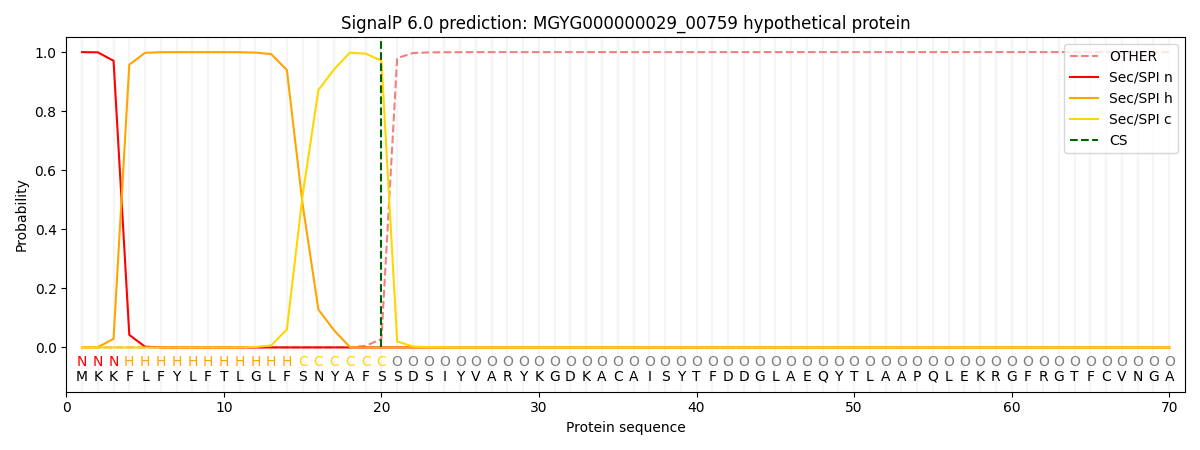You are browsing environment: HUMAN GUT
CAZyme Information: MGYG000000029_00759
You are here: Home > Sequence: MGYG000000029_00759
Basic Information |
Genomic context |
Full Sequence |
Enzyme annotations |
CAZy signature domains |
CDD domains |
CAZyme hits |
PDB hits |
Swiss-Prot hits |
SignalP and Lipop annotations |
TMHMM annotations
Basic Information help
| Species | Bacteroides finegoldii | |||||||||||
|---|---|---|---|---|---|---|---|---|---|---|---|---|
| Lineage | Bacteria; Bacteroidota; Bacteroidia; Bacteroidales; Bacteroidaceae; Bacteroides; Bacteroides finegoldii | |||||||||||
| CAZyme ID | MGYG000000029_00759 | |||||||||||
| CAZy Family | CE4 | |||||||||||
| CAZyme Description | hypothetical protein | |||||||||||
| CAZyme Property |
|
|||||||||||
| Genome Property |
|
|||||||||||
| Gene Location | Start: 195025; End: 195981 Strand: + | |||||||||||
CAZyme Signature Domains help
| Family | Start | End | Evalue | family coverage |
|---|---|---|---|---|
| CE4 | 34 | 158 | 1.5e-26 | 0.8615384615384616 |
CDD Domains download full data without filtering help
| Cdd ID | Domain | E-Value | qStart | qEnd | sStart | sEnd | Domain Description |
|---|---|---|---|---|---|---|---|
| cd10918 | CE4_NodB_like_5s_6s | 7.19e-28 | 34 | 144 | 1 | 113 | Putative catalytic NodB homology domain of PgaB, IcaB, and similar proteins which consist of a deformed (beta/alpha)8 barrel fold with 5- or 6-strands. This family belongs to the large and functionally diverse carbohydrate esterase 4 (CE4) superfamily, whose members show strong sequence similarity with some variability due to their distinct carbohydrate substrates. It includes bacterial poly-beta-1,6-N-acetyl-D-glucosamine N-deacetylase PgaB, hemin storage system HmsF protein in gram-negative species, intercellular adhesion proteins IcaB, and many uncharacterized prokaryotic polysaccharide deacetylases. It also includes a putative polysaccharide deacetylase YxkH encoded by the Bacillus subtilis yxkH gene, which is one of six polysaccharide deacetylase gene homologs present in the Bacillus subtilis genome. Sequence comparison shows all family members contain a conserved domain similar to the catalytic NodB homology domain of rhizobial NodB-like proteins, which consists of a deformed (beta/alpha)8 barrel fold with 6 or 7 strands. However, in this family, most proteins have 5 strands and some have 6 strands. Moreover, long insertions are found in many family members, whose function remains unknown. |
| cd10970 | CE4_DAC_u1_6s | 5.41e-25 | 36 | 212 | 2 | 188 | Putative catalytic NodB homology domain of uncharacterized prokaryotic polysaccharide deacetylases which consist of a 6-stranded beta/alpha barrel. This family contains uncharacterized prokaryotic polysaccharide deacetylases. Although their biological functions remain unknown, all members of the family contain a conserved domain with a 6-stranded beta/alpha barrel, which is similar to the catalytic NodB homology domain of rhizobial NodB-like proteins, belonging to the larger carbohydrate esterase 4 (CE4) superfamily. |
| cd10967 | CE4_GLA_like_6s | 6.41e-25 | 35 | 155 | 1 | 113 | Putative catalytic NodB homology domain of gellan lyase and similar proteins. This family is represented by the extracellular polysaccharide-degrading enzyme, gellan lyase (gellanase, EC 4.2.2.-), from Bacillus sp. The enzyme acts on gellan exolytically and releases a tetrasaccharide of glucuronyl-glucosyl-rhamnosyl-glucose with unsaturated glucuronic acid at the nonreducing terminus. The family also includes many uncharacterized prokaryotic polysaccharide deacetylases, which show high sequence similarity to Bacillus sp. gellan lyase. Although their biological functions remain unknown, all members of the family contain a conserved domain with a 6-stranded beta/alpha barrel, which is similar to the catalytic NodB homology domain of rhizobial NodB-like proteins, belonging to the larger carbohydrate esterase 4 (CE4) superfamily. |
| pfam01522 | Polysacc_deac_1 | 9.97e-21 | 37 | 144 | 9 | 105 | Polysaccharide deacetylase. This domain is found in polysaccharide deacetylase. This family of polysaccharide deacetylases includes NodB (nodulation protein B from Rhizobium) which is a chitooligosaccharide deacetylase. It also includes chitin deacetylase from yeast, and endoxylanases which hydrolyzes glucosidic bonds in xylan. |
| cd10917 | CE4_NodB_like_6s_7s | 2.03e-18 | 37 | 140 | 3 | 96 | Catalytic NodB homology domain of rhizobial NodB-like proteins. This family belongs to the large and functionally diverse carbohydrate esterase 4 (CE4) superfamily, whose members show strong sequence similarity with some variability due to their distinct carbohydrate substrates. It includes many rhizobial NodB chitooligosaccharide N-deacetylase (EC 3.5.1.-)-like proteins, mainly from bacteria and eukaryotes, such as chitin deacetylases (EC 3.5.1.41), bacterial peptidoglycan N-acetylglucosamine deacetylases (EC 3.5.1.-), and acetylxylan esterases (EC 3.1.1.72), which catalyze the N- or O-deacetylation of substrates such as acetylated chitin, peptidoglycan, and acetylated xylan. All members of this family contain a catalytic NodB homology domain with the same overall topology and a deformed (beta/alpha)8 barrel fold with 6- or 7 strands. Their catalytic activity is dependent on the presence of a divalent cation, preferably cobalt or zinc, and they employ a conserved His-His-Asp zinc-binding triad closely associated with the conserved catalytic base (aspartic acid) and acid (histidine) to carry out acid/base catalysis. Several family members show diversity both in metal ion specificities and in the residues that coordinate the metal. |
CAZyme Hits help
| Hit ID | E-Value | Query Start | Query End | Hit Start | Hit End |
|---|---|---|---|---|---|
| AAO79284.1 | 8.02e-116 | 24 | 318 | 249 | 541 |
| BCA48724.1 | 4.03e-113 | 24 | 318 | 334 | 626 |
| ALA73864.1 | 5.47e-105 | 21 | 315 | 331 | 627 |
| QJR79111.1 | 5.47e-105 | 21 | 315 | 331 | 627 |
| AII68092.1 | 5.47e-105 | 21 | 315 | 331 | 627 |
PDB Hits download full data without filtering help
| Hit ID | E-Value | Query Start | Query End | Hit Start | Hit End | Description |
|---|---|---|---|---|---|---|
| 5LFZ_A | 1.80e-07 | 37 | 138 | 27 | 117 | T48deacetylase [Arthrobacter sp. AW19M34-1],5LGC_A T48 deacetylase with substrate [Arthrobacter sp. AW19M34-1] |
Swiss-Prot Hits help
SignalP and Lipop Annotations help
This protein is predicted as SP

| Other | SP_Sec_SPI | LIPO_Sec_SPII | TAT_Tat_SPI | TATLIP_Sec_SPII | PILIN_Sec_SPIII |
|---|---|---|---|---|---|
| 0.000356 | 0.998962 | 0.000182 | 0.000162 | 0.000154 | 0.000153 |
